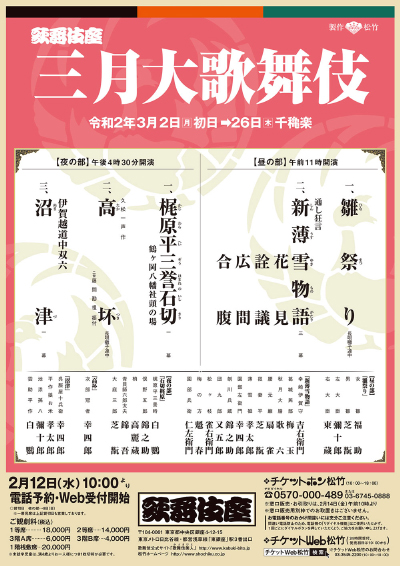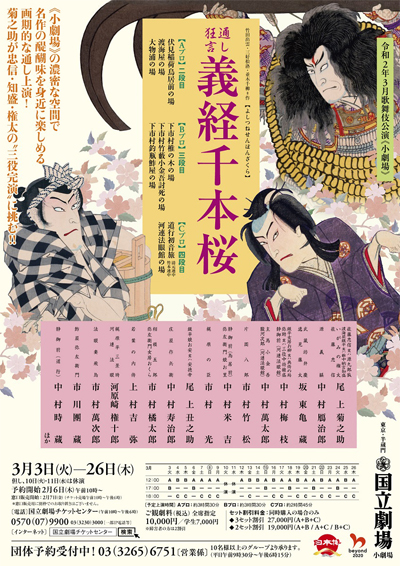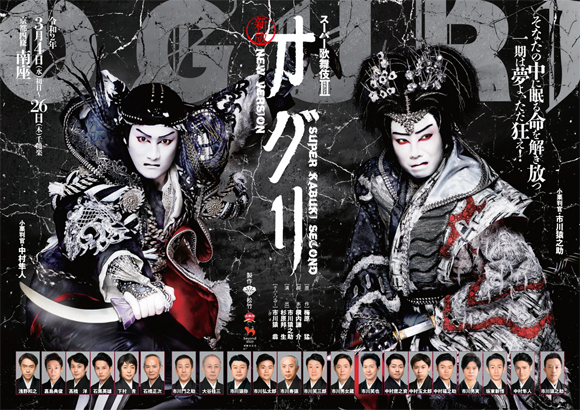| MARCH 2020 |
| Cancellation of all performances in March 2020 due to coronavirus (COVID-19)!!! |
|
4 shows in T˘ky˘ (Kabukiza, National Theatre, Meijiza), 1 in Ky˘to (Minamiza) and 1 tour (Hana no Mai Tour)!
|
| Kabukiza (T˘ky˘) |  |
| Dates | Sangatsu ďkabuki March Grand Kabuki |
| MatinÚe |
Hina Matsuri
|
| Evening | |
| Casting |
Living National Treasure Nakamura Kichiemon, Living National Treasure Kataoka Nizaemon, Living National Treasure Nakamura T˘z˘, Matsumoto Haku˘, Nakamura Shikan, Nakamura Baigyoku, Nakamura Kaishun, Nakamura Jakuemon, Matsumoto K˘shir˘, Nakamura Fukusuke, Nakamura Senjaku, Kataoka Takatar˘, Band˘ Yajűr˘, Nakamura Kinnosuke, Nakamura Matagor˘, Nakamura Karoku, ďtani Tomoemon, Ichimura Kakitsu, Ichikawa Komaz˘, Matsumoto Kingo, Nakamura Kikaku, Nakamura Matsue, Nakamura Kash˘, ďtani Hirotar˘, Nakamura Tanenosuke, Nakamura Toranosuke, Arashi Kitsusabur˘, Nakamura Kichinoj˘, Nakamura Baika, Kataoka Matsunosuke |
| Comments |
The usual March Kabuki performances at the Kabukiza.
|
 |
| National Theatre (T˘ky˘) |
| Dates | |
| Program A |
|
| Program B |
|
| Program C |
|
| Casting |
Onoe Kikunosuke, Nakamura Tokiz˘, Nakamura Ganjir˘, Ichikawa Danz˘, Ichimura Manjir˘, Kawarasaki Gonjűr˘, Kamimura Kichiya, Band˘ Kamez˘, Nakamura Baishi, Nakamura Yonekichi, Nakamura Mantar˘, Ichimura Takematsu, Nakamura Jűjir˘, Ichimura Kitsutar˘, Ichimura Hikaru, Onoe Ushinosuke |
| Comments |
The usual March Kabuki performances at the National Theatre. There are 3 programs but 1 or 2 will be performed each day:
March at National Theatre features a full-length performance of one of the great classics of Kabuki, "Yoshitsune Senbon Zakura" (Yoshitsune and the Thousand Cherry Trees). This is an epic story about the famous 12th century general Yoshitsune fleeing from the wrath of his brother Yoritomo, after the end of the war. Although Yoshitsune is the title character, the main characters of the play are actually Tomomori, Gonta and Tadanobu, the heroes of the different sections of the play. This month's production features Onoe Kikunosuke in all these major roles!
|
 |
| Meijiza (T˘ky˘) |  |
| Dates | Sangatsu Hanagata Kabuki March Young Actors Kabuki |
| MatinÚe | |
| Evening | |
| Casting |
Nakamura Kankur˘, Nakamura Shichinosuke, Nakamura Kazutar˘, Kataoka Kamez˘, Band˘ Minosuke, Band˘ Hikosabur˘, Nakamura Hashinosuke, Band˘ Shűch˘, Sawamura Yoshijir˘, Nakamura Kamenoj˘ |
| Comments |
March Young Actors Kabuki performances at the Meijiza!
|
 |
|
|||
| Dates | SűpÔ Kabuki Sekando Super Kabuki II |
||
| Program |
Shinpan Oguri |
||
| Casting |
Ichikawa Ennosuke, Nakamura Hayato, Band˘ Shingo, Ichikawa Monnosuke, Ichikawa Emisabur˘, Ichikawa Emiya, Ichikawa Omez˘, Ichikawa En'ya, Ichikawa Juen, Ichikawa K˘tar˘, ďtani Keiz˘, Nakamura Fukunosuke, Nakamura Takanosuke, Nakamura Tamatar˘, Ichikawa Otora, Asano Kazuyuki, Kashima Noritoshi, Ishibashi Sh˘ji, Shimomura Ao, Ishiguro Hideo, Takahashi Y˘ |
||
| Comments |
The SűpÔ Kabuki Sekando drama "Shinpan Oguri" is a revised version of 1991 SűpÔ Kabuki drama "Oguri".
|
||
 |
| Hana no Mai Tour | |
| Dates | Dent˘ Gein˘ Hana no Mai The Dance of Flowers (Tradional Entertainment) |
| Program | |
| Casting |
Ichikawa Udanji, ďtani Hiromatsu, Ichikawa Kudanji, Ichikawa Ukon, Ichikawa Ujaku, Ichikawa Usaji, Ichikawa Utaroku |
| Comments |
A short 10-date tour for Ichikawa Udanji, ďtani Hiromatsu, Ichikawa Kudanji and Ichikawa Ukon.
|
|
|
| Contact | Main | Top | Updates | Actors | Plays | Playwrights | Programs | Links | FAQ | Glossary | Chronology | Illustrations | Prints | Characters | Derivatives | Theaters | Coming soon | News |